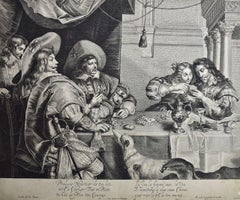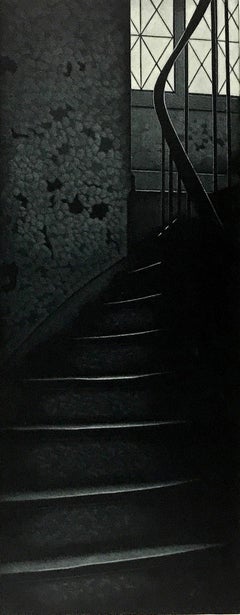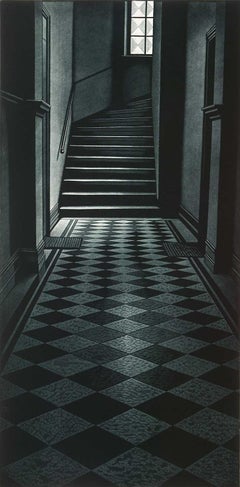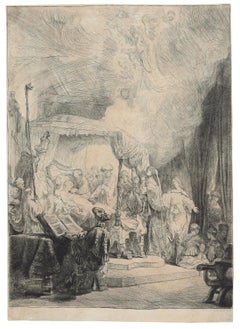1630s Interior Prints
to
1
Overall Width
to
Overall Height
to
1
1
128
226
1,100
776
11
13
21
53
35
62
85
219
254
84
105
1
1
1
Period: 1630s
The Card Game: An Early 17th Century Engraving by A. Voet after Cornelis de Vos
By Alexander Voet
Located in Alamo, CA
A 17th century engraving entitled "The Card Game" by old master artist Alexander de Voet after a painting by Cornelis de Vos, created in 1632. The pain...
Category
Old Masters 1630s Interior Prints
Materials
Engraving
Related Items
Before It Happened (A mysterious staircase offers no clues as to what happened)
Located in New Orleans, LA
This Finnish artist creates a mezzotint in black and white. This impression is #44 of 100 and is signed, dated and titled in pencil.
Jukka Vanttinen (Finn, b. 1954)
Jukka Vanttinen...
Category
Modern 1630s Interior Prints
Materials
Mezzotint
Jukka VanttinenBefore It Happened (A mysterious staircase offers no clues as to what happened), 2005
$375 Sale Price
25% Off
H 21.38 in W 8.5 in
Days Gone
Located in New Orleans, LA
Finns always seek the solace of nature. Is this mysterious stairway an escape from the challenges of civilization? Vanttinen created this mezzotint in an edition of 100 and it is tit...
Category
Contemporary 1630s Interior Prints
Materials
Mezzotint
"Untitled" Snow Window iPad Drawing. My Window No. 610.
Located in London, GB
David Hockney "Untitled" Snow Window iPad Drawing. My Window No. 610. An eight colour inkjet print on cotton fibre archival paper. Dated 2010. A limited edition of 250 prints. No. 87...
Category
Contemporary 1630s Interior Prints
Materials
Archival Pigment
$41,105
H 22.05 in W 17.01 in
Interiors IV : Hotel Paradise Cafe
By Peter Milton
Located in New York, NY
“INTERIORS IV : HOTEL PARADISE”
Contemporary artist Peter Milton created this etching and engraving in 1987. The printed Image size is 24 x 35.50 inches and the paper size is 30.75 x 41.75 inches. This impression is signed, dated, and titled in pencil, and inscribed “84/175” – the 84th impression of an edition of 175 pieces.
“I do love to draw. I feel that I am being granted membership in the Brotherhood of Merlin, conjuring forth some apparition. As a drawing develops, I sense a vague presence coming more and more into focus, something in a white fog emerging and becoming increasingly palpable.” – P. Milton, “The primacy of touch. The Drawings of Peter Milton”
“Working in layers, Milton begins with drawings based on people and places, with nods to Western art history and culture. He is a master of the appropriated image, a term that may conjure Andy Warhol and his Pop Art comrades. But Milton steps further back in history, avoiding the Pop sense of cool advertising and popular culture references. Instead, a broader cultural past is tapped through historical photographs of key players, architecture, and locales, which he reinvents by hand. He adds content drawn from his life as an avid reader – always with multiple possible interpretations – thus incorporating deeper meaning in his cinematic worlds. Elements of Greek mythology, classical music, art history, and history coalesce in his images, which embrace the messiness, sorrow, and elation that is life. One is hard-pressed to imagine a more erudite, skilled, passionate, and cheeky soul.” – T. L. Johnson and A. Shafer
Peter Milton was born in Pennsylvania in 1930. He studied for two years at the Virginia Military Institute...
Category
Contemporary 1630s Interior Prints
Materials
Engraving, Etching
Attic
Located in New Orleans, LA
This Finnish artist creates a mezzotint in black and white. This impression is #34 of 100 and is signed, dated and titled in pencil.
Jukka Vanttinen (Finn, b. 1954)
Jukka Vanttinen...
Category
Modern 1630s Interior Prints
Materials
Mezzotint
French Neoclassical design for a Pulpit, engraving after Delafosse
Located in Melbourne, Victoria
Copper-line engraving. C1768.
Delafosse was a French decorative designer, engraver and architect. Apprenticed for a time to a sculptor, by 1767 he styled himself an 'architect and professor of design'. He published the first volume of his most important work, 'Nouvelle Iconologie Historique' in 1768, containing 110 plates of his designs for furniture, decorative arts and architectural...
Category
French School 1630s Interior Prints
Materials
Engraving
Exit (Dappled sunlight in an ancient stairway leads to an uncertain end.)
Located in New Orleans, LA
Finns always seek the solace of nature. Is this mysterious stairway an escape from the challenges of civilization? Vanttinen created this mezzotint in an edition of 100 and it is tit...
Category
Contemporary 1630s Interior Prints
Materials
Mezzotint
$450
H 21.5 in W 10.75 in
French Neoclassical Design for Candlesticks, engraving after Delafosse
Located in Melbourne, Victoria
Copper-line engraving. C1768.
Delafosse was a French decorative designer, engraver and architect. Apprenticed for a time to a sculptor, by 1767 he styled himself an 'architect and professor of design'. He published the first volume of his most important work, 'Nouvelle Iconologie Historique' in 1768, containing 110 plates of his designs for furniture, decorative arts and architectural...
Category
French School 1630s Interior Prints
Materials
Engraving
French Neoclassical Design Engraving for Braziers
Located in Melbourne, Victoria
Copper-line engraving. C1768.
Delafosse was a French decorative designer, engraver and architect. Apprenticed for a time to a sculptor, by 1767 he styled himself an 'architect and professor of design'. He published the first volume of his most important work, 'Nouvelle Iconologie Historique' in 1768, containing 110 plates of his designs for furniture, decorative arts and architectural...
Category
French School 1630s Interior Prints
Materials
Engraving
Différentes Especes de Buffets et Leurs Developments, French design engraving
Located in Melbourne, Victoria
'Différentes Especes de Buffets et Leurs Developments'
(Different types of buffet and their formation)
French copper-line engraving by PL Cor after Andre Jacob Roubo (1739–1791). 18...
Category
Naturalistic 1630s Interior Prints
Materials
Engraving
$140
H 18.12 in W 11.42 in
Maniere de Prendre Les Mesures, Roubo French cabinetmaking design engraving
Located in Melbourne, Victoria
'Maniere de Prendre Les Mesures de la Menuiserie et de la Marquer sur le Plan'
French copper-line engraving by Berthault after Andre Jacob Roubo (1739–1791). 18th century laid water...
Category
French School 1630s Interior Prints
Materials
Engraving
$140
H 18.12 in W 11.42 in
French Neoclassical Design engraving for Braziers
Located in Melbourne, Victoria
Copper-line engraving. C1768.
Delafosse was a French decorative designer, engraver and architect. Apprenticed for a time to a sculptor, by 1767 he styled himself an 'architect and professor of design'. He published the first volume of his most important work, Nouvelle Iconologie Historique in 1768, containing 110 plates of his designs for furniture, decorative arts and architectural...
Category
French School 1630s Interior Prints
Materials
Engraving
Previously Available Items
The Death of the Virgin - Original Etching by Rembrandt - 1639
Located in Roma, IT
The Death of the Virgin is an etching with drypoint tweaks on wire rod double filigree paper, realized in 1639 by Rembrandt Harmenszoon van Rijn (Leiden, 1606 - Amsterdam, 1669).
Probable specimen of III state on three (according to White & Boon), IV on four (following Biörklund-Barnard).
Signature and date on plate on the lower left corner “Rembrandt f. 1639".
The paper has a cluster watermark with symmetrical elements in the center (similar to Ash Grapes B.a.) and a second watermark written on 4 lines (perhaps identifiable with Ash Words C.a.).
Superb specimen on doubly watermarked paper: the first on four lines dating back to around 1764 and widely diffused in Normandy and Germany; the second, clustered, traced back to the second decade of the 17th century. Sheet characterized by a legible and appreciable impression for the chiaroscuro; good conditions of conservation, even though some thinning is reported, in particular along the left margin and on the lower left corner, together with small gaps visible on the back and a superficial deposit of particles.
Reference:
Gersaint 1751, p. 71, n. 97; Bartsch 99; Hind 1924, n. 161; Biörklund-Barnard 1957, n. 39, IV; New Hollstein (Dutch & Flemish), n. 173 (Rembrandt); Hinterding et al. 2000 n. 32.III; White & Boon 1969, n. 99.III.
One of the most interesting works with a religious subject by the great old master, for both the compositional freedom and the technical expertise. We do not know who the customer was; it could have been a Catholic client, but this hypothesis seems to be at least doubtful precisely because of the peculiarity with which the episode is narrated. Certainly, this artwork is linked to a precise market request, given its size - this is the second largest incision of the artist - and the commitment to such an important work.
A more detailed description of this religious event is described particularly well in the Legenda Aurea by Jacopo da Varagine, a guiding text in the Middle Ages for all the artists who wanted to portray the Death of the Virgin: an angel appeared to Mary announcing her imminent death. It is told that the Apostles, dispersed in the four corners of the world to proclaim the Gospel, were miraculously transported to Mount Zion to be near them.
Disagreeing with other exegetes, Hinterding claims that Rembrandt knew the Legenda but was inspired by it in an original way, combining two moments in a single choral scene. Indeed, the scene depicted by the artist takes place in the bedroom of the Virgin: the angel appears at the top, accompanied by the cherubs, while the Apostles gather around her bed. For this marvelous etching, in addition to the aforementioned text by the Dominican friar da Varagine, Rembrandt certainly also looked at two fundamental works (to understand the genesis of the composition): the Death of the Virgin by Albrecht Dürer, from the silographic series of the Life of the Virgin, of which he owned a specimen, perhaps bought at auction in 1638, and a stained glass window designed by Dirck Pietersz Crabeth (1501-1574), in the Oude Kerk in Amsterdam. From Crabeth, he took the figure in the foreground that is reading the Holy Scriptures, perhaps the personification of the Church, and the canopy bed that stands out at the center of the scene. The young man with long hair described on the right, perhaps San Giovanni Evangelista, is instead a quotation from the Adoration of the Magi (1513) by Lucas Van Leyden, an artist much appreciated by Rembrandt. In Rembrandt's version of Mary's farewell, there are not only the Apostles: around her there are men and women, young and old, someone, intrigued, peeks out from behind the bed or a curtain, in the background, on the right, others pray kneeling...
Category
Old Masters 1630s Interior Prints
Materials
Etching
H 15.56 in W 12.41 in D 0.04 in



